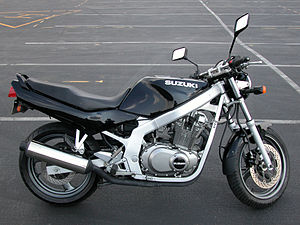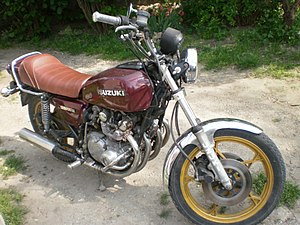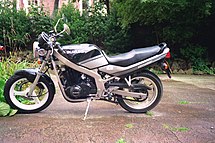
The Suzuki SV650 and its variants are street motorcycles manufactured since 1999 by Suzuki. In 2009, Suzuki replaced the standard SV650 with the SFV650 Gladius. In 2016, the Gladius name was discontinued and the 2017 model was reverted to SV650.

The Kawasaki Ninja 250R is a motorcycle in the Ninja sport bike series from the Japanese manufacturer Kawasaki originally introduced in 1986. As the marque's entry-level sport bike, the motorcycle has undergone few changes throughout its quarter-century lifetime, having received only three substantial redesigns. In some markets the Ninja 250R has been succeeded by the Ninja 300.

The term "Universal Japanese Motorcycle", or UJM, was coined in the mid-1970s by Cycle Magazine to describe a proliferation of similar Japanese standard motorcycles that became commonplace following Honda's 1969 introduction of its successful CB750. The CB750 became a rough template for subsequent designs from all three of the other major Japanese motorcycle manufacturers. In 2011, the New York Times said lightning struck for Honda "with the 1969 CB 750, whose use of an inline 4-cylinder engine came to define the Universal Japanese Motorcycle."
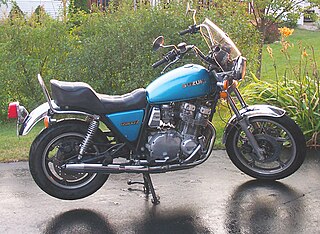
The Suzuki GS series was Suzuki Motor Corporation's first full range of 4-stroke powered road motorcycles, having previously almost exclusively manufactured 2-stroke machines. Suzuki had produced the 4-stroke Colleda COX 125cc and 93cc 4-stroke single-cylinder machines in 1955 however the rest of Suzuki's production from 1952 to 1976 had been increasingly sophisticated two-stroke road machines, whose ultimate expression was the 750cc 3-cylinder water-cooled GT750.

The Kawasaki Ninja 500R is a sport bike with a 498 cc (30.4 cu in) parallel-twin engine, part of the Ninja series of motorcycles manufactured by Kawasaki from 1987 to 2009, with a partial redesign in 1994. Although the motorcycle has a sporty appearance, it offers a more standard, upright riding position with greater comfort and versatility. It provides a combination of performance and low operating costs, which has made it a favorite as a first motorcycle with new riders and popular with experienced riders on a budget. 2009 was the last model year for the Ninja 500.
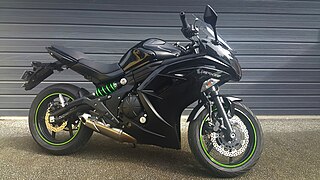
The Kawasaki Ninja 650R, also called ER-6f or EХ-6, is a motorcycle in the Ninja series from the Japanese manufacturer Kawasaki Motors sold since 2006. The 2012 model drops the R suffix from its name. It is a middleweight, parallel-twin engined motorcycle, designed for normal use on paved roads. They have modern styling and features, with low-seating ergonomics and a low center of gravity. The engine has a 180° crankshaft, resulting in an uneven firing interval of 0° and 540°.

The Kawasaki Concours, known as the GTR1000 in some markets, is a 1,000 cc sport touring motorcycle manufactured between 1986 and 2006 by Kawasaki. In 2007 it was replaced by the larger displacement Concours 14, also known as the 1400GTR.

The Suzuki GSX-R750 is a sports motorcycle made by Suzuki since 1984. It was introduced at the Cologne Motorcycle Show in October 1984 as a motorcycle of the GSX-R series for the 1985 model year.

The Suzuki Boulevard S40 is a lightweight cruiser motorcycle manufactured by the Suzuki Motor Corporation for the Japanese domestic market, and exported to New Zealand, North America, as well as to Chile and other countries.

The Suzuki RE5 is a motorcycle with a liquid-cooled single-rotor Wankel engine, manufactured by Suzuki from 1974 to 1976. Apart from its unusual engine, the RE5 is mostly a conventional roadster, albeit with some peculiar styling details thanks to Italian industrial designer Giorgetto Giugiaro.

The Suzuki GT750 is a water-cooled three-cylinder two-stroke motorcycle made by Suzuki from 1971 to 1977. It is the first Japanese motorcycle with a liquid-cooled engine. The Society of Automotive Engineers of Japan(in Japanese) includes the 1971 Suzuki GT750 as one of their 240 Landmarks of Japanese Automotive Technology.
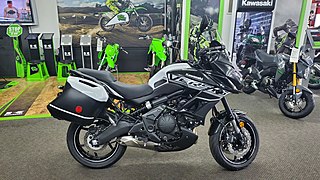
The Kawasaki Versys 650 is a middleweight motorcycle. It borrows design elements from dual-sport bikes, standards, adventure tourers and sport bikes; sharing characteristics of all, but not neatly fitting into any of those categories. The name Versys is a portmanteau of the words versatile and system. It was introduced by Kawasaki to the European and Canadian markets as a 2007 model and to the US market in 2008. A California emissions compliant version was released in 2009. In 2010 new styling was applied to the headlight and fairings and several functional changes made including enlarged mirrors and improved rubber engine mounts. In 2015, a new model was introduced with a new fairing style that abandoned the older, stacked headlights for the more conventional twin headlight style commonly found on sportbikes.

The Kawasaki GPz750 was a sport bike introduced by Kawasaki in 1982. In comparison with the KZ750, it had many updates focusing on high performance. Changes started at the front, with tapered bearings in the steering head instead of the KZ750's ball bearings, and the upper triple clamp was changed also, giving the GPz solid aluminum clip-on handle grips instead of the traditional handlebar. A bikini fairing almost identical to the one on the GPz550 was added too. The GPz750 had increased power, with slightly higher compression, and camshafts designed to get the valves to full lift quicker, and fitting Mikuni 34mm carburetors for smoother airflow. The cylinder heads were also given a new combustion chamber, and porting and polishing from the factory. An oil-cooler was also added. The GPz750 was the quickest factory 750, as Cycle World recorded a time of 11.93 seconds at 109.62 mph (176.42 km/h) in the 1/4 mile. The GPz750 underwent some significant changes in 1983. The original was based on the 1981 KZ750-E. Kawasaki retired the KZ750 after 1983. The 1983 KZ750L3 was nearly identical to the '82 GPz750, but for different colors, no bikini fairing, and without the porting & polishing in the cylinder head.

The Hyosung GT250 is part of Hyosung's GT series. It shares many parts with its larger displacement siblings and it came in two flavors: GT250 (Comet) (naked bike) and GT250R (sports bike). The GT250 Comet came out in 2004, with the "Comet" suffix being dropped for the newly fuel injected 2010 model. The GT250R came out at the same time and although it seems it never officially had the "Comet" suffix, early fairings do seem to have Comet stickers. Specs are mostly the same, making the appearance the main difference between the two.

The Suzuki TS series is a family of two-stroke, dual-sport motorcycles made by Suzuki since 1969. The series was the first Suzuki trail bikes sold on the mass market. Most of the TS line had an air-cooled engine and most models were introduced alongside the closely related TM (Motocross) or TC (trail) models, TF (farm) and also the DS which in most cases shared engine and chassis designs. Suzuki's first mass market motocross bike, the TM400 Cyclone, was introduced in 1971 and was based on the TS that first sold in 1969. A TS185ER model was available in a few countries.

The A7 Avenger is a 350 cc (21 cu in) Kawasaki motorcycle sold 1967 through 1971.
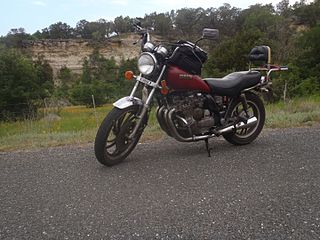
The Yamaha XJ650 Maxim is a mid-size motorcycle by the Yamaha Motor Company introduced in 1980 as the Maxim I and produced through 1983. Yamaha designed the high-performance XJ650 as a brand-new four-cylinder with shaft drive, and built it specifically as a special cruiser. The XJ Maxim was the successor of the XS Special introduced in 1978.

The Kawasaki Ninja 300, or EX300, is a 296 cc (18.1 cu in) Ninja series sport bike introduced by Kawasaki in 2012 for the 2013 model year. It is sold in Asia, Australia, Europe, and North America. When introduced, the Ninja 300R replaced the Ninja 250R in some markets, and in others they were sold alongside each other. When the 2018 model year Ninja 400 was introduced, it replaced the 300 in some markets.
Forced induction in motorcycles is the application of forced induction to a motorcycle engine. Special automotive engineering and human factors considerations exist for the application of forced induction with motorcycles, compared to other forms of motorized transportation.
